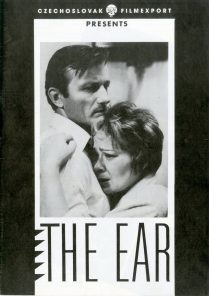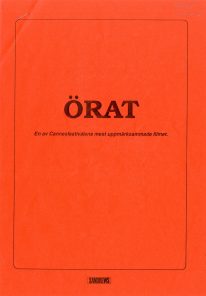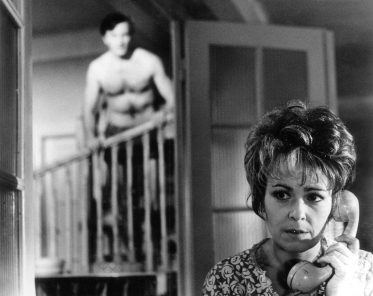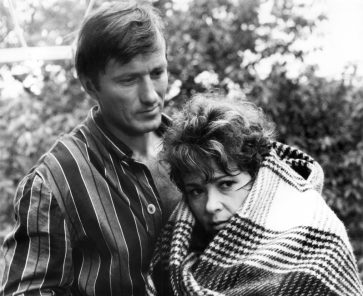When you mention The Ear (Ucho, 1969) in a film discussion, many people will immediately think of a “vault film”. Hardly any Czechoslovak film embodies the term so much as this political thriller by Karel Kachyňa and Jan Procházka. Despite its delicate theme, the film was finished after the events of August 1968 but with the exception of several closed-door screenings for the Barrandov Studios management and party officials, no one was allowed to see it until 1989. Its fate was similar to Menzel’s Larks on a String (Skřivánci na niti, 1969) – it was banned right after its completion.
The Ear was the last of a series of films in which Karel Kachyňa and Jan Procházka gradually and chronologically revised our national history. After debunking myths about the Second World War and its heroes (Long Live the Republic! [Ať žije republika!, 1965], A Carriage Going to Vienna [Kočár do Vídně, 1966]), their focus shifted on the collectivisation and show trials in the era of Stalinism (The Nun’s Night [Noc nevěsty, 1967), A Ridiculous Gentleman [Směšný pán, 1969]). The Ear takes place in an unspecified time but one of the characters is Czechoslovak President Antonín Novotný so it should be taking place between 1957 and 1968. While writing the script, Procházka drew inspiration from his own experience as in the early 1960s, he found out that he was followed and wiretapped by the State Security.
Procházka started writing the script in which included his own feelings aroused by constant state surveillance in 1969, a year after the Warsaw Pact Invasion of Czechoslovakia. Together with Kachyňa, who helped him to write the script, they realised that in light of the changing political climate, they probably won’t have much time left to make the film. Bending under the circumstances, Procházka and Kachyňa finished the literary script unusually fast, in about two months. The production itself then took another two months. Kachyňa, who studied cinematography, had already devised a thought-out visual concept so the work progressed nicely. The interiors were built in the Hostivař Studios and according to Radoslav Brzobohatý, the film had to be shot partially in secret without any deviations from the script.
The Ear’s protagonists are a well-of married couple – deputy minister Ludvík and his wife Anna. The couple was portrayed by Radoslav Brzobohatý and Jiřina Bohdalová who at that time formed a couple themselves, which only increased the intensity of the film’s tense dialogues. One night, Ludvík and Anna return from a government reception to their Prague villa. Already at the gate, Ludvík suspiciously inspects a car parking nearby. As they have lost their keys, Ludvík has to “break in” to his own home through the basement. When he wants to open the front door to let Anna in, he finds out that it’s already open and the keys are in the lock. The couple initially believes that it’s just a series of coincidences. But they slowly succumb to an atmosphere of fear.
Their house is the only one in the entire street with a power outage and Ludvík is convinced that someone broke in and planted bugs. He believes they are under surveillance and because of the ubiquitous “ear,” he starts to watch his tongue. He wishes to take back some pro-reform beliefs corresponding to Procházka’s progressive political orientation. At first, Anna doesn’t take him seriously and keeps trivialising the situation. But she jokes only to hide her fear which are getting harder to conceal. In the end, however, she faces it with more courage than Ludvík. This ambivalence reflected the attitude of Procházka and his friends who accepted “their” surveillance with a mixture of irony and genuine fear for their lives and freedom.
Even though the couple is well-off, has their own driver, house and plenty of high-quality food, the suspicion that there is an “ear” in their house reveals their helplessness. The state apparatus represents an unreachable entity which, just like a horror monster, can hypothetically lurk behind every corner and in every dark nook and cranny. Except for the toilet, where they don’t suspect the presence of the “ear,” the house becomes a dangerous place. That is emphasised by the visual stylisation of the film – grotesque and naturalistic – which was created by cinematographer Josef Illík and Ester Krumbachová. The characters seem to be trapped in confined rooms lit only by candlelight. Our view of them is often obscured by walls or furniture surrounding them. The used dominant framing method doesn’t give them much space. As if the house didn’t belong to them and they couldn’t be free in it. Private and public space merge into one.
Ludvík, increasingly convinced of his guilt, tries to re-enact the party in flashbacks and wants to find out why others looked at him so surprised and what was it he said or did. In the end, it turns out the couple wasn’t paranoid. Their suspicion is confirmed when they find a bug.
It is for this very reason that Ludvík’s final discovery that he was promoted to minister without any prior notice is so chilling. One of the mechanisms the ruling party uses to remain in power is information control. No one can be sure what others know, who’s a part of the system and who’s not and who has got access to the current “truth.” No one can be trusted and the society crumbles into scared and suspicious individuals. The inability to make decisions in one’s own life is inflated to absurd proportions when Ludvík, consumed by the pressure, attempts to commit suicide. He fails because the secret police confiscated his gun.
The film alludes to specific chapters in Czechoslovak history, such as the trial with the former General Secretary of the Communist Party Rudolf Slánský, which formed Procházka’s political awareness. In the film, Ludvík finds out that one of the apprehended politicians was of Jewish origin. Slánský was arrested in 1951 and executed a year later for an alleged Zionist conspiracy against the party. Other allusions reflect Procházka’s five-year-term as a Central Committee candidate and the period of insecurity following the Warsaw Pact invasion. In addition to exploring the methods of terror the party used on its own members, The Ear also gives an exceptionally suggestive testimony of the deformation of people facing a system limiting freedom.
Procházka and Kachyňa were also legitimately afraid of what was to come. In 1971, Procházka, a significant exponent of the Prague Spring, succumbed to the effects of an illness, political pressure and medial lynch. In March 1970, the television broadcast a programme titled The Seine Testimony (Svědectví od Seiny) based on manipulation of his secretly recorded statements. Procházka’s voice can be heard uttering sentences he never said. One of the pretences to discredit the author was The Ear. Even though the film was directed by Kachyňa, the main responsibility was attributed to Procházka as the person behind its idea. As a skilled filmmaker, Kachyňa was allowed to continue making films despite his role in creating one of the most famous vault films.
A second version of Procházka’s script was created in 1980s. Exiled writer Pavel Kohout adapted it for the Austrian Television as Das Ohr (1983). He cast Pavel Landovský as one of the State Security agents. A third, more loose adaptation of Procházka’s story, was made by Ivo Trajkov in 2015. The Macedonian film Honey Night (Noc miodowa, 2015) was screened also in Czech cinemas. Procházka’s daughter Lenka also utilised the sharp dialogues from the claustrophobic film and adapted The Ear into a chamber theatre play in 2010.
Martin Šrajer




